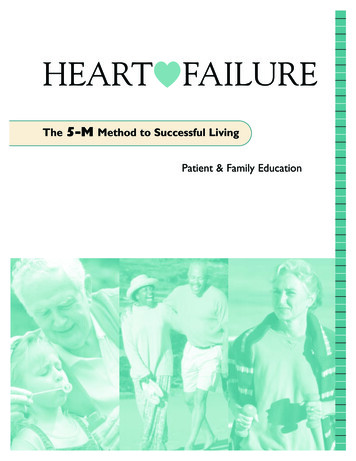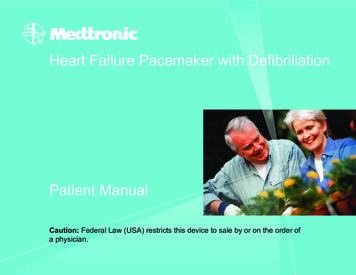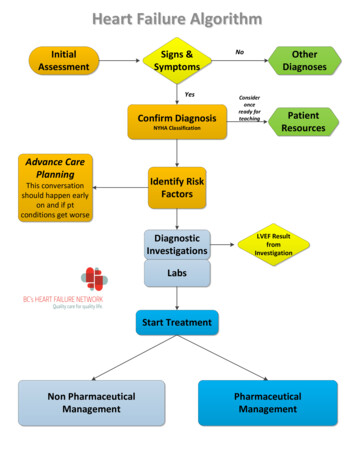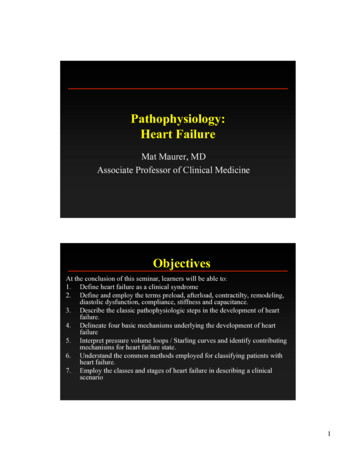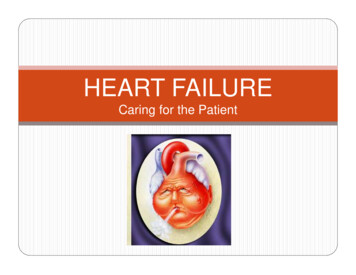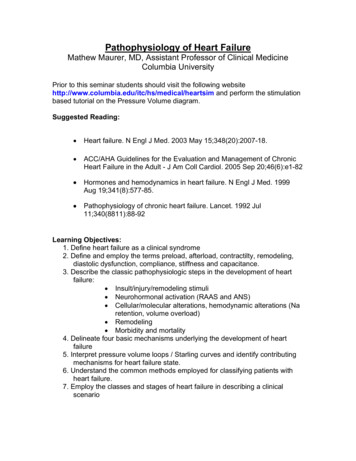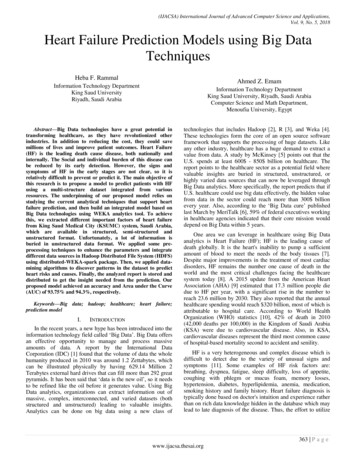
Transcription
(IJACSA) International Journal of Advanced Computer Science and Applications,Vol. 9, No. 5, 2018Heart Failure Prediction Models using Big DataTechniquesHeba F. RammalAhmed Z. EmamInformation Technology DepartmentKing Saud UniversityRiyadh, Saudi ArabiaInformation Technology DepartmentKing Saud University, Riyadh, Saudi ArabiaComputer Science and Math Department,Menoufia University, EgyptAbstract—Big Data technologies have a great potential intransforming healthcare, as they have revolutionized otherindustries. In addition to reducing the cost, they could savemillions of lives and improve patient outcomes. Heart Failure(HF) is the leading death cause disease, both nationally andinternally. The Social and individual burden of this disease canbe reduced by its early detection. However, the signs andsymptoms of HF in the early stages are not clear, so it isrelatively difficult to prevent or predict it. The main objective ofthis research is to propose a model to predict patients with HFusing a multi-structure dataset integrated from variousresources. The underpinning of our proposed model relies onstudying the current analytical techniques that support heartfailure prediction, and then build an integrated model based onBig Data technologies using WEKA analytics tool. To achievethis, we extracted different important factors of heart failurefrom King Saud Medical City (KSUMC) system, Saudi Arabia,which are available in structured, semi-structured andunstructured format. Unfortunately, a lot of information isburied in unstructured data format. We applied some preprocessing techniques to enhance the parameters and integratedifferent data sources in Hadoop Distributed File System (HDFS)using distributed-WEKA-spark package. Then, we applied datamining algorithms to discover patterns in the dataset to predictheart risks and causes. Finally, the analyzed report is stored anddistributed to get the insight needed from the prediction. Ourproposed model achieved an accuracy and Area under the Curve(AUC) of 93.75% and 94.3%, respectively.Keywords—Big data; hadoop; healthcare; heart failure;prediction modelI.INTRODUCTIONIn the recent years, a new hype has been introduced into theinformation technology field called „Big Data‟. Big Data offersan effective opportunity to manage and process massiveamounts of data. A report by the International DataCorporation (IDC) [1] found that the volume of data the wholehumanity produced in 2010 was around 1.2 Zettabytes, whichcan be illustrated physically by having 629.14 Million 2Terabytes external hard drives that can fill more than 292 greatpyramids. It has been said that „data is the new oil‟, so it needsto be refined like the oil before it generates value. Using BigData analytics, organizations can extract information out ofmassive, complex, interconnected, and varied datasets (bothstructured and unstructured) leading to valuable insights.Analytics can be done on big data using a new class oftechnologies that includes Hadoop [2], R [3], and Weka [4].These technologies form the core of an open source softwareframework that supports the processing of huge datasets. Likeany other industry, healthcare has a huge demand to extract avalue from data. A study by McKinsey [5] points out that theU.S. spends at least 600 - 850 billion on healthcare. Thereport points to the healthcare sector as a potential field wherevaluable insights are buried in structured, unstructured, orhighly varied data sources that can now be leveraged throughBig Data analytics. More specifically, the report predicts that ifU.S. healthcare could use big data effectively, the hidden valuefrom data in the sector could reach more than 300 billionevery year. Also, according to the „Big Data cure‟ publishedlast March by MeriTalk [6], 59% of federal executives workingin healthcare agencies indicated that their core mission woulddepend on Big Data within 5 years.One area we can leverage in healthcare using Big Dataanalytics is Heart Failure (HF); HF is the leading cause ofdeath globally. It is the heart's inability to pump a sufficientamount of blood to meet the needs of the body tissues [7].Despite major improvements in the treatment of most cardiacdisorders, HF remains the number one cause of death in theworld and the most critical challenges facing the healthcaresystem today [8]. A 2015 update from the American HeartAssociation (AHA) [9] estimated that 17.3 million people diedue to HF per year, with a significant rise in the number toreach 23.6 million by 2030. They also reported that the annualhealthcare spending would reach 320 billion, most of which isattributable to hospital care. According to World HealthOrganization (WHO) statistics [10], 42% of death in 2010(42,000 deaths per 100,000) in the Kingdom of Saudi Arabia(KSA) were due to cardiovascular disease. Also, in KSA,cardiovascular diseases represent the third most common causeof hospital-based mortality second to accident and senility.HF is a very heterogeneous and complex disease which isdifficult to detect due to the variety of unusual signs andsymptoms [11]. Some examples of HF risk factors are:breathing, dyspnea, fatigue, sleep difficulty, loss of appetite,coughing with phlegm or mucus foam, memory losses,hypertension, diabetes, hyperlipidemia, anemia, medication,smoking history and family history. Heart failure diagnosis istypically done based on doctor's intuition and experience ratherthan on rich data knowledge hidden in the database which maylead to late diagnosis of the disease. Thus, the effort to utilize363 P a g ewww.ijacsa.thesai.org
(IJACSA) International Journal of Advanced Computer Science and Applications,Vol. 9, No. 5, 2018clinical data of patients collected in databases to facilitate theearly diagnosis of HF patients is considered a challenging andvaluable contribution to the healthcare sector. Early predictionavoids unwanted biases, errors and excessive medical costs,which improve quality of life and services provided to patients.It can identify patients who are at risk ahead of time andtherefore manage them with simple interventions before theybecome chronic patients. Clinical data are available in the formof complex reports, patient‟s medical history, and electronicstest results [12]. These medical reports are in the form ofstructured, semi-structured and unstructured data. There is noproblem to use structured data for the prediction model. But,there is a lot of valuable information buried in the semistructured and unstructured data format because those data arevery discrete, complex, and noisy [13]. In our study, wecollected patient‟s reports from a well-known hospital in SaudiArabia: King Saud University Medical City (KSUMC). Theobjective of our research is to mine the useful information fromthese reports with the help of cardiologists and radiologist todesign a predictive model that will give us the prediction ofHF. The paper is organized as follows. Section II introducesthe related work. Section III describes the proposedarchitectural model and each process involved. In Section IV,the proposed research methodology is explained. Theconclusion and future work of this research are found inSection V.II.LITERATURE REVIEWBig Data predictive analytics represents a new approach tohealthcare, so it does not yet have a large or significantfootprint locally or internationally. To the best of ourknowledge, no prior work has investigated the benefits of BigData analytics techniques in heart failure prediction problem. Awork by Zolfaghar K, et al. [14] proposed a real-time Big Datasolution to predict the 30-day Risk of Readmission (RoR) forCongestive Heart Failure (CHF) incidents. The solution theyproposed included both extraction and predictive modeling.Starting with the data extraction, they aggregate all neededclinical & social factors from different recourse and thenintegrated it back using a simple clustering technique based onsome common features of the dataset. The predictive model forthe RoR is formulated as a supervised learning problem,especially binary classification. They used the power ofMahout as machine learning based Big Data solution for thedata analytics. To prove quality and scalability of the obtainedsolutions they conduct a comprehensive set of experiments andcompare the resulted performance against baseline nondistributed, non-parallel, non-integrated dataset resultspreviously published. Due to their negative impacts onhealthcare systems' budgets and patient loads, RoR for CHFgained the interest of researchers. Thus, the development ofpredictive modeling solutions for risk prediction is extremelychallenging. Prediction of RoR was addressed by, Vedomske etal. [15], Shah et al. [16], Royet al. [17], Koulaouzidis et al.[18], Tugerman et al. [19], and Kang et al. [20]. Although ourstudied problem is fundamentally different as they are all usingstructure data; nevertheless, our proposed model could benefitfrom the proposed large-scale data analysis solutions.Panahiazar et al. [21] used a dataset of 5044 HF patientsadmitted to the Mayo Clinic from 1993 to 2013. They applied5 training algorithms to the data that includes decision trees,Random Forests, Adaboost, SVM and logistic regression. 43predictors were selected which express demographic data, vitalmeasurements, lab results, medication, and co-morbidities. Theclass variable corresponded to survival period (1-year, 2-year,5-year). 30% of the dataset were used for training and the rest70% for testing. The authors observed that logistic regressionand Random Forests were more accurate models compared toothers, also among the scenarios, the best prediction accuracywas 87.12%.Saqlain, M. et al. [22] worked on 500 HF patients from theArmed Forces Institute of Cardiology (AFIC), Pakistan, in theform of medical reports. They started by manually applyingpre-processing steps to transform unstructured reports into thestructured format to extract data features. Then they performmultinomial Naïve Bayes (NB) classification algorithm tobuild 1-year or more survival prediction model for HFdiagnosed patients. The proposed model achieved an accuracyand Area under the Curve (AUC) of 86.7% and 92.4%,respectively. Even though the above model is based on someattributes extracted from the unstructured data, they used amanual approach to achieve this.On the other hand, our model deals with unstructured databy automatically recognizing attributes using MachineLearning (ML) approaches without the need for a radiologistopinion. A scoring model for HF diagnosis based on SVM wasproposed by Yang, G. et al. [23]. They applied it to a total of289 samples clinical data collected from Zhejiang Hospital.The sample was classified into three groups: healthy group,HF-prone group, and HF group. They compared their results toprevious studies which showed a considerable improvement inHF diagnosis with a total accuracy of 74.44%. Especially inHF-prone group, accuracy reaches 87.5%, and this implies thatthe proposed model is feasible for early diagnosis of HF.However, accuracy in the HF group is not so satisfied due tothe absence of symptoms and signs and also due to the highprevalence of conditions that may mimic the symptoms andsigns of heart failure.More studies were listed in Table I, which was collectedand summarized as recent analytics techniques and platform topredict heart failure. The table shows that supervised learningtechnique is the most dominant techniques in building HFprediction model, also Weka and Matlab are the preferableplatforms to build HF prediction model.The literature presented above shows a gap in multistructured predictors for HF prediction and data fusion whichwill be our main task. It is easy to observe that our effort isorthogonal to this related work but, unlike us, none of theseworks deal with the problem semi-structured or unstructuredHF predictor variable. They did not generate Big Dataanalytics prediction model, nor do they perform on large scaleor distributed data.364 P a g ewww.ijacsa.thesai.org
(IJACSA) International Journal of Advanced Computer Science and Applications,Vol. 9, No. 5, 2018TABLE I.AuthorZolfaghar K, et al (2013)STATE OF ART FOR HF PREDICTION STUDIESPrediction Technique UsedLogistic regression, RandomforestPlatformObjectiveMahoutBD solution to predict the 30- day RoR of HFLogistic regression, NaiveBayes, Support Vector MachinesREvaluation preprocessing techniques for Prediction ofRoR for CHF PatientsYang, G. et al (2010)support vector machine (SVM)n/aA heart failure diagnosis model based on supportvector machinePanahiazar et al. (2015)Decision trees, Random Forests,Adaboost, SVM and logisticregressionn/aUsing EHRs and Machine Learning for Heart FailureSurvival AnalysisDonzé, Jacques et al (2013)Cox proportional hazardsSASAvoidable 30-Day RoR of HFK. Zolfaghar et al (2013)Naive Bayes classifiersRIntelligent clinical RoR of HF calculatorBian, Yuan et al (2015)Binary logistic regressionn/aScoring system for the prevention of acute HFSuzuki, Shinya et al (2012)logistic regressionSPSSScoring system for evaluating the risk of HFAuble, T. E. et al (2005)Decision treeSPSSPredict low-risk patients with HFPocock, S. J. et al (2005)Cox proportional hazardsn/aPredictors of Mortality and Morbidity in patients withCHFCox proportional hazardsRPrediction for HF incidence within 1-yearDecision Trees, Naïve Bayes,and Neural NetworksWekaHD prediction system using DM classificationtechniquesRupali R. Patil (2014)Naive Bayes classifiersMATLABRupali R. Patil (2012)Artificial Neural networkWekaA DM approach for prediction of HDWu, Jionglin et al (2010)Logistic regression, SVM, andBoostingSAS, RHF prediction modeling using EHRZebardast, B. et al (2013)Generalized Regression NeuralNetworksMATLABDiagnosing HDVanisree K. & Singaraju J.(2011)Multi-layered Neural NetworkMATLABDecision Support System for CHD DiagnosisGuru N. et al. (2007)Neural networkMATLABHD prediction systemR, Chitra and V, Seenivasagam(2013)Cascaded Neural Networkn/aHD Prediction SystemSellappan Palaniappan andRafiah Awang (2008)Decision trees, naïve bayed andneural network.NetHD prediction system using DM techniquesK. Srinivas et al (2010)Naive Bayes classifiersWekaDM technique for prediction of Heart AttacksSaqlain, M. et al (2016)Naive Bayesn/aMiao, Fen et al (2014)S.Dangare et al (2012)Strove, Sigurd et al (2004)Gladence, L.M. et al (2014)Supervised learningMeadam N., et al (2013)HUGINWekaMicrosoftAzure (R &python)n/aIdentification of HF using unstructured data ofCardiac PatientsDecision Support Tools in Systolic HF ManagementMethod for detecting CHFFramework to recommend interventions for 30-DayRoR of HFHD PredictionGini index, Z-statics & geneticsalgorithmn/aDecision Support System for HD predictionassociation rule mining andclassificationJavaAlgorithm for prediction of HDStructured prediction(Bayesian network)C. Ordonez (2006)Association rulesK. Chandra Shekar et al (2012)AssociativeclassificationLiu, Rui et al (2014)M. Akhil Jabbar et al. (2012)HD prediction system365 P a g ewww.ijacsa.thesai.org
(IJACSA) International Journal of Advanced Computer Science and Applications,Vol. 9, No. 5, 2018Structured Data (Patient Demographics)Standardizedformat (Missingattribute / differentformat)Unstructured Data (Patient CXR)Semi-structured Data (PatientHistory)Remove stopwordFeaturesextraction(Haar wavelet)Featuresextraction(LBP)Data stemming(porter stemmer)Data Pre-processingDistributed WekaMap ReducerHDFSData Storage (Hadoop)Data fusionSVMDecisionEnsembleSVMtreeEnsembledecision treeEvaluation(Accuracy / precision / recall/ AUC)Data ClassificationHF Prediction ModelFig. 1. HF prediction model.366 P a g ewww.ijacsa.thesai.org
(IJACSA) International Journal of Advanced Computer Science and Applications,Vol. 9, No. 5, 2018III.PROPOSED ARCHITECTUREPredictive analysis can help healthcare providers accuratelyexpect and respond to the patient needs. It provides the abilityto make financial and clinical decisions based on predictionsmade by the system. Building the predictive analysis modelincludes various phases as mentioned in the literature (Fig. 1shows the complete architecture of proposed model). Layer 1: Data collection from KSUMC in the form ofstructure, unstructured, and semi-structured. Layer 2: Data pre-processing to prepare and filter thedataset to make it ready for the next step in building themodel. Layer 3: Data fusion and storage which is an importantlayer that used to integrate all preprocessed data andstore it in HDFS to be then fed to the next step. Layer 4: Data classification and evaluation are the twofinal steps that include training, testing then evaluatingthe model.IV.B. Data PreprocessingIn this phase structured, semi-structured, and unstructureddata are accumulated, cleansed, prepared, and made ready forfurther processing.TABLE II.CharacteristicFemaleMaleAge(mean SD)A. Data CollectionIn our study, we collaborated with King Saud UniversityMedical City (KSUMC) system located in Riyadh, SaudiArabia to extract manually all needed clinical and demographicthat we needed to adapt to evaluate the performance of theproposed model in identifying HF risk, from January 2015 toDecember 2015.The dataset contained 100 real patient records extractedform KSUMC Electronic Health Record (EHR) and PictureArchiving Communication System (PACS), with approvalfrom KSUMC administrative office. Due to patients‟ privacy,some demographic information that includes name, national IDnumber or iqama number, phone, address were excluded, Basiccharacteristics of the samples‟ demographic information areshown in Table II. Obviously, our sample doesn‟t have auniform distribution in terms of gender. Also, patients agedfrom 60 years old to 70 years old account for the most part ofour data. One of the major steps is the distillation of data,which responsible of determining the subset of attributes (i.e.,predictor variables) that has a significant impact in predictingpatient with HF from the myriad of attributes present in thedataset. In this study, parameters are selected from 3 datasetswhich are summarized in Table III.The validation of the selected dataset achieved byconsolidating some cardiologist and according to theirevaluation all cases were labeled into two groups. The selecteddataset has many noises such as missing values andmisidentified attributes. The output values were categorizedinto two labels denoted as Non-HF (meaning HF is absent) andHF (meaning HF is present). Our dataset contains 69 predictorvariable, having 1 binary variables (gender) 3 text values (placeof birth, history, and symptoms) and 65 numerical variables(including age and all CXR features) and a single responsevariable „Result‟ having only two values HF and Non-HF.GroupHF group2125Non-HF group2331Total445669 1261 1565 14TABLE III.SELECTED ATTRIBUTES FROM THE inicalindications /HistoryUnStructuredFront CXRBack CXRSide CXRPROPOSED METHODOLOGYIn the following, we will describe the adapt methodologyand each step in toward our proposed model.DEMOGRAPHIC BASIC CHARACTERISTICSFeatureAgeSexPlace of birthHypertension, Anemia,Diabetes, Chronic KidneyDisease, Ischemic heartdisease, SOB, Swillinghands, Cough, PreviousCHF64 Features (Haar)FormatNumeralBinaryNominalStringNumeral61 Features (LBP) Raw structured information has some missing valuesand written in different formats during informationentry or management. Those data with too manymissing attributes were all wiped off when we selectedthe dataset. Also, all data formats were standardized,see Table IV. Apply text analysis techniques on the semi-structureddataset to get the needed information. Three steps wereapplied to the text to process the data, tokenizer, stopword removal, and stemming. Before any real textprocessing is to be done, the text needs to be segmentedinto words, punctuation, phrases, symbols, and othermeaningful elements called tokens. Next, stop wordremoval, illustrated in Fig. 2, helped in removing allcommon words, such as „a‟ and „the‟ from the text.Then, Porter algorithm was used as the stemmer toidentify and remove the commoner morphological andinflexional endings from words, which is part of thesnowball stemmers in WEKA [24].TABLE IV.UNSTANDARDIZED STRUCTURED DATAAgeSexP BDiagnosis1045YFemaleRiyadhHF262F?HF . . . .100098maleriyNon-HFExplanatory DataLabel367 P a g ewww.ijacsa.thesai.org
(IJACSA) International Journal of Advanced Computer Science and Applications,Vol. 9, No. 5, 2018Fig. 4. The result from wavelet.Fig. 2. Stop word removal. Extracting all needed features from the unstructureddataset, which includes 3 types of Chest X-Ray (CXR)images (front CXR, back CXR, and side CXR) usingMATLAB. Haar wavelet and local binary pattern (LBP)were applied to over 150 CXR images. Haar was usedsince it is the fastest technique that can be used tocalculate the feature vector [25]. This was performedbased on applying the Haar wavelet 4 times to dividethe input image into 16 sub-images, illustrated in Fig. 3.64 features that include Energy, Entropy, Homogenouswere found, Fig. 4 illustrate the resulted images afterfirst level of Haar. Each CXR image represents certainfeatures in the image of heart values ofEnergy Entropy Homo and wavelet features. A total of16 for Energy Entropy Homo in each level since wehave 4 levels in Haar wavelet so 64 features areextracted in total. On the other hand, LBP has beenfound to be a powerful and simple feature yet veryefficient texture operator which labels the pixels of animage by calculating each pixels‟ neighborhoods‟thresholding then considers the result as a binarynumber. We applied LBP to all CXR images by first,labeling all the pixels, absent the borders, using theLBP operator, then dividing the image into 60segments. A feature vector is created by obtaining thehistogram of each region, and finally concatenating allthe histograms into one vector which result in finding60 features. A typical LBP application to a CXR isshown in Fig. 5.Fig. 3. Applying haar wavelet four times.Fig. 5. Histogram of image obtained by applied LBP algorithm on CXR:(a) LBP applied image and (c) histogram before LBP (b) histogram of a. Principle component analysis (PCA) was applied toproperly rank and compute the weights of the featuresto find the most promising attributes to predict HF fromthe features found. The selected attributes were used totrain the classifiers to get a better accuracy. Also, tocircumvent the imbalanced problem, we appliedresampling method. This method alters the classdistribution of the training data so that both the classesare well represented. It works by resampling the rareclass records so that the resulting training set has anequal number of records for each.C. Data Storage and FusionAfter pre-processing the data and extracting all the neededattributes, the statistics feature from CXR scan images withother attributes will be integrated using data fusion techniquesto generate the needed data that will be used for training andtesting and finally produce the predictive model.Complementary data fusion classification technique was usedas each dataset represents part of the scene and was used tobuild a reliable information. We leverage the power of Hadoopas a framework for distributed data processing and storage.Hadoop is not a database, so it lacks functionality that is368 P a g ewww.ijacsa.thesai.org
(IJACSA) International Journal of Advanced Computer Science and Applications,Vol. 9, No. 5, 2018necessary for many analytics scenarios. Fortunately, there aremany options available for extending Hadoop to supportcomplex analytics, including real-time predictive models suchas Weka (Waikato Environment for Knowledge Analysis),which we used in our study. We added distributed WekaSparkto Weka‟ which works as a Hadoop wrapper for Weka.D. Data ClassificationIn this study, each set of the data (Structured, Semistructured, and Unstructured) trained and tested using datamining algorithms in Weka. Knowledge flow was used inWeka which presents, a workflow inspired interface, see Fig. 6.Data was trained using two state-of-the-art classificationalgorithms including, Random Forest (RF) and LogisticRegression (LR) as they both have been known to result inhigh accuracy in binary class prediction.The ability to handle and analyze various types of data(structured, semi-structured or unstructured) is one of the mostimportant characteristics of Big Data analytic techniques. Wewill perform the classifications in two phases to show thatusing the proposed integrated learning analytics technique ismore efficient than a traditional single predictive model,especially if the data is multi-structured and has uniquecharacteristics. In the end, model quality was assessed throughcommon model quality measures such as accuracy, precision,recall and, Area under the Curve (AUC). Depending on thefinal goal of the HF prediction, the different evaluationmeasures are less or more appropriate. Recall is relevant as thedetection of patients that belong to HF class is the main goal.The precision is considered less important as cost related tofalsely predicting patients to belong to the class HF is low. Theaccuracy is the traditional evaluation measure that gives aglobal insight in the performance of the model. The AUCmeasure is typically interesting in our study because theproblem is imbalanced. It is observed that the number ofinstances with HF label significantly outnumbers the numberof instances with class label Non-HF.V.RESULTS AND INSIGHTSIt is clear from Tables V and VI that integrated dataset hasthe highest accuracy and AUC: 92% and 90%, respectively,then using each dataset by its own for HF patient‟s prediction.Also, using LBP features extraction methods achieved betterperformance results then Haar with 93% compared to 91% forHaar. We can also note that logistic regression did great in theintegrated models compared to its poor performance in thesingle dataset models with over 90% recall, which can beresulted from the nature of the algorithm as it predicts betterfor problems with many attributes. Based on the experiment,we can provide evidence of the importance of the integration ofunstructured, semi-structured, and structured data. Thisindicates that there are some indicators within textual patientreport and images that can be extracted and used as importantpredictors of Heart failure. Also, the discovery of featureselection as a suite of methods that can increase modelaccuracy, decrease model training time and reduce overfitting.Our proposed approach is also very important because itprovides a knowledge discovery and intelligent model to thecardiologists and researchers such as: (1) the dataset contains56% male patients, which mean male patients have moreprobability to get an HF diagnose than females. (2) 73%patient‟s age over 65 which indicate that aged people havemore chance to get HF. (3) 70% of patients coming for HFcomplain having hypertension, diabetes, and SOB whichmeans this disease has the main impact of HF.Fig. 6. The Proposed Knowledge flow using distributed Weka.369 P a g ewww.ijacsa.thesai.org
(IJACSA) International Journal of Advanced Computer Science and Applications,Vol. 9, No. 5, 2018TABLE V.CLASSIFICATION r)Un-Structured(LBP)IntegratedDataset (Haar)IntegratedDataset (LBP)TABLE VI.VI.A PERFORMANCE MEASURE BASED ON RANDOM 87.59087.594.393.394.293.3A PERFORMANCE MEASURE BASED ON LOGISTIC REGRSSIONCLASSIFICATION ar)Un-Structured(LBP)IntegratedDataset (Haar)IntegratedDataset 1.780.391.693.393.394.393.3Big Data Analytics provides a systematic way for achievingbetter outcomes of healthcare service. Non-CommunicableDiseases like Heart Failure is one of a major health problemsinternationally. By transforming various health records of HFpatients to useful analyzed result, this analysis will make thepatient understand the complications to occur. The literatureshows a gap in multi-structured predictors for HF predictionand data fusion which is our main task. It is easy to observethat our effort is orthogonal to this related work but, unlike us,none of these works deal with the problem semi-structured orunstructured HF predictor variable. Combining severalcharacteristics from each patient demographical information,patient clinical information, and patient‟s Chest X-Ray is avery hard task. In this research, data fusion played a vital rolein combining multi-structure dataset. We extracted differentimportant factors of heart failure from King Saud Medical City(KSUMC) system. The extracted data were in the form ofstructured (patients demographics), semi-structured (patienthistory and clinical indication), and un-structured (patient chestX-Ray) data. Then we applied some preprocessing techniquesto enhance the parameters of each dataset. After that, data wasstored in HDFS to be trained and tested using differentmodeling algorithms on two phases to compare theperformance measures of the resulted models before and afterintegrating them in the first phase we train each dataset as atraditional single predictive. Then, we integrated the mostpromising attributes form all dataset in the second phase andbuild 2 models based on Haar and LBP feature extraction. Theresults showed that the performances of the classifiers werebetter using the fused data ( 93 % accuracy). For furtherimproving, other intelligent algorithms need to beprospectively analyzed as well and more subjects should beinvestigated to keep upgrading the classifier. We will alsoincorporate more medical data into the model, better simulatinghow a cardiologist makes a deci
Data analytics, organizations can extract information out of massive, complex, interconnected, and varied datasets (both structured and unstructured) leading to valuable insights. Analytics can be done on big data using a new class of technologies that includes Hadoop [2 ], R 3 , and Weka 4 .



